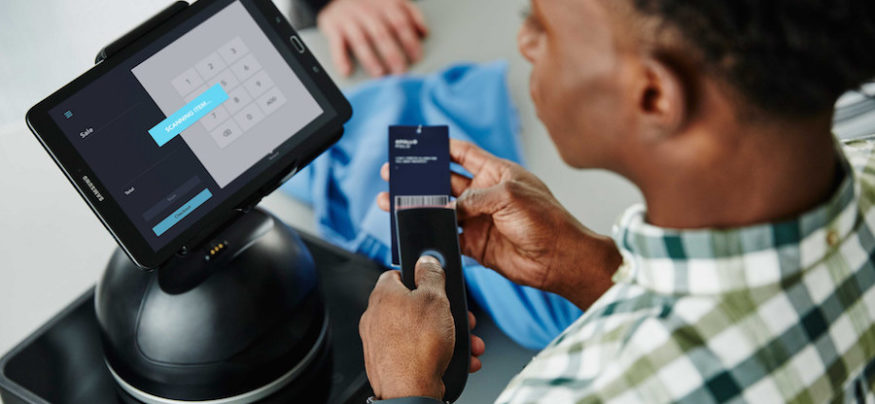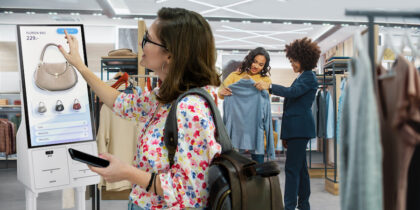A tablet-based kiosk solution lets retailers improve the customer experience with convenience, self-service and instant access to information. The technology is becoming more popular because off-the-shelf tablets can now be easily customized to create a flexible and affordable interface for any application.
Define Your Objectives
As there are many different ways to configure tablets, you’ll want to ensure you choose a kiosk solution that best aligns with your objectives and intended use. Consider what role the tablet kiosk will play in the retail environment and how it will serve the end user. For example:
- Will the kiosk complement or alleviate staff duties?
- On average, how many customers will be interacting with it?
- Are there environmental considerations?
- Will it be used to help customers find more information on products?
- Will it be used for buy online pick up in store (BOPIS) services?
- Will it enable ordering, and will there be payments involved?
Defining the objectives of the kiosk can help ensure the equipment and applications are designed from the ground up to meet the needs of the end user and provide an enhanced in-store experience.
Find the Right Equipment and Location
Tablet-based kiosks are growing in popularity because they are more flexible, smaller and less expensive than bulky traditional kiosks. When outfitted with the right stands and equipment, these devices can be configured in a number of ways to suit different types of setups. They can also be placed virtually anywhere, including on walls, counters, store shelves and endcaps. This level of configuration makes them ideal for different types of interaction points throughout your store.
A device such as the Samsung Galaxy Tab can be equipped with a variety of enclosures and peripherals to be quickly converted into a kiosk. Tablet customization also offers the ability to install apps and lock down the device for single-purpose use. This gives retailers the ability to make devices accessible to consumers to find the information they need, while also ensuring it isn’t used for nefarious purposes.
Create the Shopping Experience of the Future
This guide explains how IoT tools can close the gaps in your omnichannel retail strategy. Download Now
Location is an important consideration, and you’ll want to evaluate what areas of the store receive the most foot traffic to maximize usage. When positioned properly, kiosks can potentially reduce lines and staff workloads, and can help customers get timely service.
You’ll also want to consider how you’ll manage and control your devices. Through the Knox Configure platform, you can remotely configure device settings, restrictions, apps and content — enabling you to easily create a tablet purpose-built for the kiosk from the ground up.
Assisting the Customer Experience
Kiosks should be promoted, and signage should clearly identify its location and indicate what it can be used for. There should also be signage indicating basic steps and instructions for using it.
Even though the technology is designed to be self-servicing, it’s important that staff monitor the setup to keep it functional throughout the day. Associates should be able to troubleshoot errors, help consumers or upkeep the machine.
You’ll also want to ensure the kiosk solution integrates with your POS software and CRM applications. This way, customers can easily pull up their reward accounts, view in-store inventory or place orders. The user interface should be simple and clear to guarantee that customers can navigate the menus and quickly find the information or functions they need.
Ensuring Data Security
Finally, because kiosks are subject to PCI regulations, accessed by multiple users and can have unique vulnerabilities, it is essential that your customized tablets have a high level of security. The tablet should be placed in a mounted tamper-proof case to ensure physical protection from the elements and from unscrupulous users.
Galaxy tablets come fully equipped with Samsung Knox, a defense-grade security platform that protects the device hardware, software and data. Knox can reduce the risk of hacking, and features overlapping defense mechanisms to protect against intrusion, malware and malicious threats.
Furthermore, the Knox platform brings convenient device management capabilities through solutions like Knox Configure and Knox Manage. These functions include out-of-the-box setup, device enrollment, dynamic update pushes, whitelisting and blocklisting, and even data separation. This combination will help IT staff keep all devices up-to-date and provide a way for them to easily maintain the technology.
A customized tablet-based kiosk can be a valuable tool in improving any customer experience. With the proper planning, hardware integration and IT support, you’ll be able to easily upgrade your in-store environment for long-term shopper engagement.
Looking for more cutting-edge retail solutions? Check out our full line of innovative retail technology.








